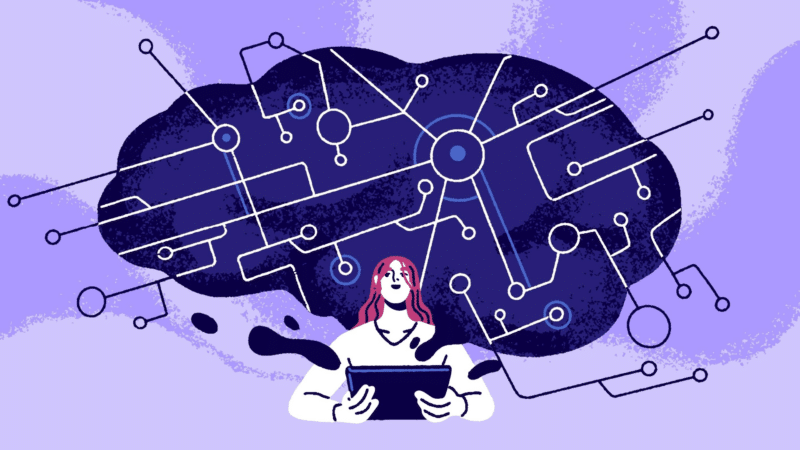
Remember when “digital transformation” meant getting everyone on email? Those days feel quaint now. When I attended the Marketing AI Conference last year, it struck me that AI leaders asked fundamentally different questions. Not “Can AI make this faster?” but “What becomes possible now that wasn’t before?”
Across boardrooms worldwide, executives focus on implementing AI — but often overlook a more profound truth: no technology can succeed without a shift in mindset. The hardware and software may arrive overnight, but upgrading how we think takes much longer.
Moving from a ‘linear’ organization to a ‘hyperadaptive’ one
Our current marketing organizations operate with industrial-age precision. Information travels upward for approval. Decisions flow downward with revisions. Authority correlates with position. This is a “linear organization,” plagued with friction (delay) and loss of fidelity (drift).

Problems trigger predetermined solutions from (sometimes) dusty digital playbooks. Unfortunately, this approach, so well-oiled for the industrial age, falters in a world wired for speed.
Contrast this with “hyperadaptive organizations,” which function as living systems rather than static ones. They:
- Sense their environment.
- Process information collaboratively.
- Respond with remarkable speed.
Beyond merely executing strategy, they evolve continuously through real-time insights.

When McDonald’s implemented edge computing infrastructure, it embodied a hyperadaptive organization, starting with its infrastructure. Individual locations process data locally while simultaneously feeding insights into collective intelligence networks. This advanced architecture enables marketing decisions at unprecedented speeds while maintaining system-wide learning.
These approaches require a mindset shift to move away from tweaking and toward reimagining what an organization can be with AI.
Dig deeper: How to unlock the true potential of AI with adaptive structure
Moving from tiny steps to bigger leaps
Marketing teams particularly face an inflection point between refining and reinventing processes. While it is valuable to examine productivity gains, this mindset limits AI’s transformational potential.
A recent McKinsey report shared the story of an industrial materials distributor who didn’t just take tiny steps with AI; they took leaps. Rather than simply automating lead scoring, they thought through their entire customer acquisition process.
The old process had individuals driving around town in their cars, looking for construction sites (those were the leads!) and then bringing them “back to the office” for scoring. Their new AI engine doesn’t just prioritize existing leads; it reinvents sales and marketing processes by using public data sources to:
- Analyze building permits.
- Identify construction trends.
- Then build personalized email outreach.
The result was over $1 billion in previously invisible business opportunities and doubling customer engagement rates.
That demonstrates the mindset leap from “doing things better” to “doing better things.” The question shifts from “How can AI improve our marketing?” to “What if we completely rethought how we connect with customers in an AI-integrated world?”
Novartis similarly transformed its approach across organizational functions. Their strategy didn’t simply layer AI onto broken pharmaceutical processes. Instead, they mapped critical workflows, identified bottlenecks and optimized fundamental operations before strategically introducing targeted AI solutions. Their efforts yielded:
- 30% reduction in process times.
- 25% efficiency increase.
- 600% reduction in data ingestion time for commercial analytics.
Beyond metrics, their researchers gained freedom from mundane tasks. Scientists previously trapped in data management now focus on discovering life-changing medicines. Value creation shifted fundamentally, not incrementally.
This suggests an exciting path forward. Continue to experiment with AI, but also schedule time to consider new possibilities with AI as a foundational element. Marketing organizations that make this mental leap will move beyond working faster to creating entirely new ways of marketing.
Dig deeper: AI readiness checklist: 7 key steps to a successful integration
A growth mindset, where learning never stops
Think about your personal experience. In linear organizations:
- Learning is treated as episodic.
- Training happens in scheduled intervals.
- Knowledge transfers go through formal channels.
- Expertise calcifies into specialized departments.
Hyperadaptive environments, on the other hand, demand perpetual learning. Knowledge flows continuously between humans and AI systems, creating bidirectional teaching relationships where people train algorithms while algorithms illuminate new insights for people.
This perpetual growth mindset exceeds Carol Dweck’s original concept of the Growth Mindset. Beyond believing you can learn, it requires accepting that continuous adaptation represents the only option in an AI-integrated world.
The ego revolution in decision-making
Nowhere does AI demand a bigger mindset shift than in decision-making processes. Well-intentioned executives routinely make decisions based on limited information, cognitive biases and personal experiences poorly matched to current conditions.
Most organizations suffer from the “HiPPO effect,” where the “highest paid person’s opinion” carries more weight than evidence. Status trumps insight, hierarchy overrides datan and the corner office outranks research.
AI-enhanced decision-making fundamentally challenges this status quo. When systems instantly analyze vast datasets and generate evidence-based recommendations, value shifts dramatically from having opinions to asking insightful questions and thoughtfully interpreting evidence.
This shift challenges leaders whose authority has long relied on having the answers. It’s the difference between teams locked in debates over which photo to use and those using AI to test thousands of variations simultaneously. Hyperadaptive leaders prioritize creating environments where better questions and evidence — not ego — drive decisions.
Dig deeper: The secret to smarter, faster marketing decisions with AI
The intersection of fast and slow thinking
Truth: AI moves faster than the human brain can process. Daniel Kahneman’s distinction between fast, intuitive thinking (System 1) and slow, deliberative reasoning (System 2) gains new relevance for marketers integrating AI, but with a challenging twist.
AI systems process information with astonishing speed, generating insights, recommendations and content at rates that overwhelm human cognitive capacity. When marketers receive real-time analytics dashboards showing thousands of customer behaviors, campaign performance metrics across dozens of channels and competitive intelligence updates by the minute, System 2 thinking (our deliberative, analytical mode) quickly becomes overwhelmed.
In other words, the technology designed to enhance decision-making impairs it by triggering cognitive overload.
Successful marketing teams shift their mindset to recognize this dynamic and design their AI integrations to support, not overwhelm human judgment. They work to create interfaces that:
- Filter signals from noise.
- Highlight actionable insights.
- Present information at a pace compatible with deliberative thinking.
The most powerful marketing AI applications throttle results and create conditions to enhance our capacity for System 2 thinking. They do this by removing cognitive load and expanding our ability to engage in complex reasoning when it matters most.
Rather than replacing human judgment, effective systems create space for better judgment through:
- Improved information availability.
- Reduced bias.
- Enhanced cognitive bandwidth for truly consequential decisions.
The mindset shift involves moving from “How fast can our AI analyze data?” to “How effectively can our AI enhance our team’s ability to think deeply about what matters most?” When marketers make this transition, they create capabilities for breakthrough innovation rather than merely accelerating existing processes.
Mindset as a key component of AI integration
Transitioning to a hyperadaptive organization involves technological integration, but mindset evolution determines success or failure.
Marketers must move beyond AI as a tool for task completion and see it as a catalyst for reimagining their day-to-day work. Leaders need to embrace perpetual learning over episodic training. Most challenging, everyone must navigate the ego revolution from valuing evidence over opinion.
What will you do to overcome the gravitational pull of outdated thinking in our new world?m valuing evidence over opinion.
What will you do to overcome the gravitational pull of outdated thinking in our new world?
The post Why mindset, not just tech, defines AI success in marketing appeared first on MarTech.
